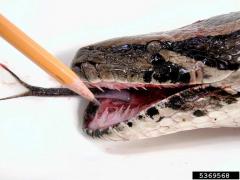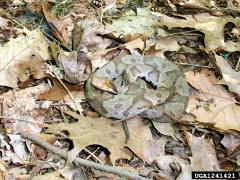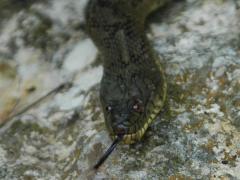Invasive Species: Python molurus ssp. bivittatus, Burmese Python
The Burmese python, one of the largest snake species in the world, has been reported as invading the Everglades since the 1980s. It is a large predator that has a significant negative impact on the native wildlife in the areas it invades. Several pregnant females have been captured from the wild. A female Burmese python usually lays 12 to 36 eggs but can lay as many as 100 eggs; the gestation period is 60 to 90 days. This nonvenomous constrictor can attain a length of 26 ft. (8 m), although it may not typically grow that large in the wild. The Burmese python is dark colored, with many brown blotches bordered in black down its back. Considered semiaquatic, it also is a good climber. It is one of the most commonly kept exotic snakes in the pet trade. Moreover, people have released their pet pythons when the snakes have grown too large or become too expensive to care for easily. These factors have ensured a large population of these snakes in the wild. More than 1,800 Burmese pythons were removed from the Everglades between 2000 and 2011; however, it is believed that this number represents only a fraction of the actual population. In 2012, the U.S. government instituted a ban on the importation and transfer across state lines of Burmese pythons and three other species of constrictor snakes. The Burmese python’s native range is from India to lower China, the Malay Peninsula, and some islands of the East Indies, where it typically lives near water.
What are invasive species, and why should we be concerned about them?
Taxonomy: Scientific and Common Names for This Species
Squamata > Pythonidae > Python molurus ssp. bivittatus Kuhl, 1820
Synonyms: None
Distribution Maps
Burmese python – The reported distribution of this invasive species across the United States (Source: EDDMapS)
Up-to-the-minute distribution maps and why they are important
Reporting This Invasive Species
What is the best way to report the occurrence of an invasive species?
How to report an invasive species sighting to EDDMapS – Early Detection & Distribution Mapping System
EDDMapS – Report an invasive species to EDDMapS.
County Extension Offices – Find your county Extension office on this map provided by USDA.
How to Identify
This invasive species can be identified by looking for the characteristics described in the paragraphs that follow.
Adult Snakes
The Burmese python is a constrictor that can reach a length of 26 ft. (8 m), although it may not typically grow that large in the wild. It is dark colored, with many brown blotches bordered in black down its back. The markings allow the snake to blend well with its surroundings in the Everglades.


 |
 |
| Skip Snow, National Park Service, bugwood.org | Lori Oberhofer, National Park Service, bugwood.org |
Young
 |
 |
| Lori Oberhofer, National Park Service, bugwood.org | Lori Oberhofer, National Park Service, bugwood.org |
Eggs
A female Burmese python usually lays 12 to 36 eggs but can lay as many as 100 eggs. The gestation period is 60 to 90 days.
 |
 |
| Lori Oberhofer, National Park Service, bugwood.org | Lori Oberhofer, National Park Service, bugwood.org |
Native Snake Species That Resemble Burmese Python
Although Burmese pythons grow larger than all snakes native to North America, smaller Burmese pythons may resemble venomous and nonvenomous native snakes.
Venomous
Agkistrodon contortrix, copperhead – Images at invasive.org
 |
 |
| James Henderson, Golden Delight Honey, bugwood.org | Arnold T. Drooz, USDA Forest Service, bugwood.org |
Crotalus adamanteus, eastern diamondback rattlesnake – Images at invasive.org
 |
 |
| James Henderson, Golden Delight Honey, bugwood.org |
Rebekah D. Wallace, University of Georgia, bugwood.org |
Nonvenomous
Nerodia erythrogaster transversa, blotched water snake – Images at invasive.org
 |
 |
| Karan A. Rawlins, University of Georgia, bugwood.org |
Karan A. Rawlins, University of Georgia, bugwood.org |
Additional Images for Burmese Python
Burmese python – Images at invasive.org
Learning Resources for Burmese Python
Video: Invasion of the Giant Pythons – PBS
Burmese python Fact Sheet – National Park Service
Additional Information, Biology, Control and Management Resources
Control and management recommendations vary according to individual circumstances. Location, habitat, weather, and a variety of other conditions are factors that help determine the best treatment choice. To find the safest and most effective treatment for your situation, consult your state’s land-grant institution. If you will use chemicals as part of the control process, always refer to the product label.
United States Land Grant University System – Find your Land Grant University’s College of Agriculture, University Cooperative Extension Service, or other related partner on this map provided by USDA.
Global Invasive Species Database – Invasive Species Specialist Group (ISSG)
Stopping a Burmese Python Invasion – The Nature Conservancy
Science Features – U.S. Geological Survey (USGS)
NAS – Nonindigenous Aquatic Species – USGS
Florida’s Nonnative Wildlife: Species detail. – Florida Fish and Wildlife Conservation Commission
Identification of Burmese Pythons – Florida Fish and Wildlife Conservation Commission
EDIS Publication – University of Florida, Institute of Food and Agricultural Sciences (IFAS) Extension
Florida Invaders: English – National Park Service
Florida Invaders: Spanish – National Park Service
Florida Invaders: Creole – National Park Service
Activity Guide for Teachers – National Park Service
